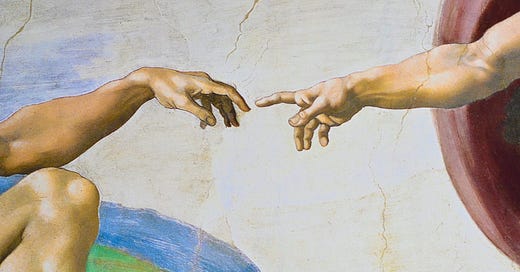The Renaissance is not the best period in art history. In fact, there is neither a best part or a Renaissance at all, nor is there Impressionism, Modernism or any other label attributed to art history.
The very notion that art throughout time has been divided into different periods, with each distinct and hierarchal was made up by people in the ‘Renaissance’ to champion there own time. And the ideals that we use to say a piece, an artist or even a whole movement is good or bad was, too, decided by these men: we look for realism, for imagination as well as a spectacle- think Sistine chapel level of grandeur- all of which are commonly associated with the Renaissance.
It was these men that wanted to be seen as the pinnacle of what humanity could achieve and they were able to create a narrative that did just that. We look back at the Italian Renaissance as the highest point in the history of art, with all movements after working from it and all before leading up to it. Art history itself is centered around it.
How did we get here?
The word Renaissance literally means rebirth.
The idea that culture and, but extension art, needed to change dramatically was an idea created by Petrarch.
Petrarch was an Italian scholar who criticised his own time period of the 14th century and instead favoured Ancient Rome, where perfection was sought and the Italian empire was strong- a sharp contrast to his world of dark Medieval Italy. But his intellectual snobbery and subjectivity was not fashioned into what we would call art history until Vasari.
Vasari was working in the ‘high Renaissance,’ with this label being of his own creation. In his book ‘The Lives of Artists’ he draws from Petarch’s ideas, tracing art’s ‘rebirth’ out of the depth of the Greek (Byzantine) period with a renewed interest in antiquity and drawing directly from nature. Artists like Giotto mapped the ‘childhood of art,’ then Donatello and Botticelli in art’s adolescence, before reaching the pinnacle of art of his own time, in his own time place of Florence with the ‘Maturity of Art’ of da Vinci, Raphael, Titian and, his personal favourite, Michelangelo.
This carefully curated narrative that works solely to favour his home town and own time period is damaging in that it limits our understanding of the individual merit of different periods. In fact, this sectioning of art history ignores the fact that art cannot be limited to a liner narrative like this, with one movement neatly following another.
Whilst Vasari’s system does aid our comprehension of art history (he literally made the study of art history), it leads to this idea that some of these prescribed periods are better than others, just a Vasari claimed.
Another issue with our understanding of art history being based off Vasari’s is that his was propaganda.
Vasari and the Medici family
The Medici family were a powerful banking family in Italy over the course of the ‘Renaissance.’ They also invested in slavery, and, in art.
Duke Ferdinand Medici saw the power that could be held in controlling the cultural narrative to centre his time period, his hometown and his family. In order to do this, he became Vasari’s patron, backing his book but only if the result was flattering.
And so, the first edition opened to the Medici family crest and was paid by their investments in slavery.
The narrative crafted in imbued with ideas of racial and cultural superiority, with this championing of Italy as a opposed to all other places- a narrative used to justify slavery further with this rhetoric superiority over the peoples they enslaved, the lands they colonised and the cultures they replaced with their own.
Furthermore, misogyny is present in the narrative he crafts as well. No female artists are mentioned in the text, feeding into the humanist ideas of the time period. Humanism dictated that humans held power over the world, and the world was the centre of the universe. But this narrative specifically highlighted male accomplishments. Women had secondary narratives, or else were completely written out. Men gained power in the Renaissance, but women lost. Any economic, social, political or cultural power they had had in the Medieval period was now a symptom of a backwards time, and women were in, supposedly, their rightful place in this new era of the Renaissance.
And so, by honouring this linear narrative created by Vasari, we honour misogynistic and racist narratives.
But, is it possible to recreate this narrative to champion those previously put down by it? Maybe, but definitely not while still considering the Western Renaissance as the peak of art, and definitely not by believing anything Vasari said, especially as he was prone to believe rumour and the exaggerated himself, as long as it worked well with his narrative.
In conclusion, art history cannot be contained in a linear narrative, but as for alternatives, it’s difficult to tell. First of all, there’s the issue of deprogramming: how can we change our own view of art history if all around us it this narrative? In museums, galleries, books and timelines.
But there is still the question of, what should it be replaced with?
Questions to consider:
Do you have a favourite period in art history? Do you think you can argue that it is the best?
Is it possible to study art history without using this linear narrative?
Currently reading: The Conquest of America by Tzvetan Todorov
Random Recommendation: I AM SHAMPOO by BIBI




